Benedicts solution Study guides, Revision notes & Summaries
Looking for the best study guides, study notes and summaries about Benedicts solution? On this page you'll find 73 study documents about Benedicts solution.
Page 2 out of 73 results
Sort by
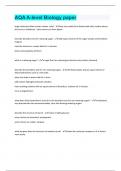
-
AQA A-level Biology paper | Questions With 100% Correct Answers | Verified
- Exam (elaborations) • 20 pages • 2023
- Available in package deal
-
- £12.56
- + learn more
large molecules often contain carbon. why? - they can readily form bonds with other carbon atoms. this forms a 'backbone'. other atoms can then attach. describe benedicts test for reducing sugars - add equal volumes of the sugar sample and benedicts reagent. heat the mixture in a water bath for 5 minutes. brick red precipitate will form. what is a reducing sugar? - a sugar that can reduce (give electrons to) another chemical. describe the benedicts test for non reducing sugars - with fo...
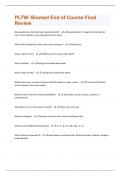
-
PLTW- Biomed End of Course Final Review Questions And Answers 2024 Updates
- Exam (elaborations) • 20 pages • 2024
- Available in package deal
-
- £6.48
- + learn more
How quickly does the body lose heat after death? - Approximately 1.5 degrees Fahrenheit per hour until it reaches surrounding environment temp Who did the fingerprint at the crime scene belong to? - Alex Garcia What is rigor mortis? - stiffening of the muscles after death What is lividity? - Pooling of the blood after death What is algor mortis? - Cooling of the body after death What causes your muscles to become stiff after death, or rigor mortis? - The loss of ATP which lasts for about ...
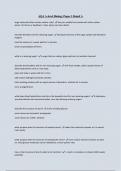
-
AQA A-level Biology Paper 1 Rated A
- Exam (elaborations) • 19 pages • 2024
-
- £10.53
- + learn more
AQA A-level Biology Paper 1 Rated A large molecules often contain carbon. why? they can readily form bonds with other carbon atoms. this forms a 'backbone'. other atoms can then attach. describe benedicts test for reducing sugars reagent. add equal volumes of the sugar sample and benedicts heat the mixture in a water bath for 5 minutes. brick red precipitate will form. what is a reducing sugar? a sugar that can reduce (give electrons to) another chemical. describe the ...
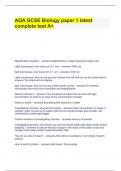
-
AQA GCSE Biology paper 1 latest complete test A+
- Exam (elaborations) • 9 pages • 2023
-
- £8.10
- + learn more
AQA GCSE Biology paper 1 latest complete test A+ Magnification equation - answers Magnification= image size/actual object size Light microscope- how many um in 1 mm - answers 1000 um light microscope- how many nm in 1 um - answers 1000 nm Light microscope- why can we see the nucleus and cell wall but not the mitochondria - answers Too small and not stained light microscope- how can we see smaller parts of cells - answers An electron microscope has muc...
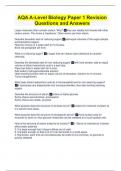
-
AQA A-Level Biology Paper 1 Revision Questions and Answers
- Exam (elaborations) • 15 pages • 2024
- Available in package deal
-
- £8.10
- + learn more
Large molecules often contain carbon. Why? they can readily form bonds with other carbon atoms. This forms a 'backbone'. Other atoms can then attach. Describe benedicts test for reducing sugars add equal volumes of the sugar sample and benedicts reagent. Heat the mixture in a water bath for 5 minutes. Brick red precipitate will form. What is a reducing sugar? a sugar that can reduce (give electrons to) another chemical. Describe the benedicts test for non reducing sugars with food s...
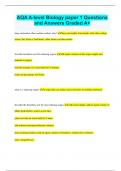
-
AQA A-level Biology paper 1 Questions and Answers Graded A+
- Exam (elaborations) • 33 pages • 2024
- Available in package deal
-
- £9.48
- + learn more
large molecules often contain carbon. why? they can readily form bonds with other carbon atoms. this forms a 'backbone'. other atoms can then attach. describe benedicts test for reducing sugars add equal volumes of the sugar sample and benedicts reagent. heat the mixture in a water bath for 5 minutes. brick red precipitate will form. what is a reducing sugar? a sugar that can reduce (give electrons to) another chemical. describe the benedicts test for non reducing sugars with food sam...
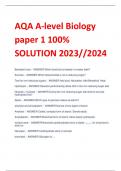
-
AQA A-level Biology paper 1 100% SOLUTION 2023//2024
- Exam (elaborations) • 15 pages • 2023
- Available in package deal
-
- £12.16
- + learn more
AQA A-level Biology paper 1 100% SOLUTION 2023//2024 Benedict's test - ANSWER Which food test is heated in a water bath? Sucrose - ANSWER Which disaccharide is not a reducing sugar? Test for non-reducing sugars - ANSWER Add acid. Neutralise. Add Benedicts. Heat. Hydrolysis - ANSWER Reaction performed by dilute HCl in the non reducing sugar test. Glucose + fructose - ANSWER During the non-reducing sugar test what is sucrose hydrolysed into? Alpha - ANSWER Which type of glucose makes ...
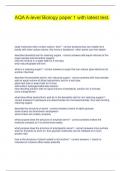
-
AQA A-level Biology paper 1 with latest test.
- Exam (elaborations) • 15 pages • 2024
- Available in package deal
-
- £11.59
- + learn more
AQA A-level Biology paper 1 with latest test. large molecules often contain carbon. why? - correct can readily form bonds with other carbon atoms. this forms a 'backbone'. other atoms can then attach. describe benedicts test for reducing sugars - correct equal volumes of the sugar sample and benedicts reagent. heat the mixture in a water bath for 5 minutes. brick red precipitate will form. what is a reducing sugar? - correct answers.a sugar that can reduce (give el...
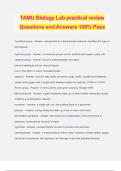
-
TAMU Biology Lab practical review Questions and Answers 100% Pass
- Exam (elaborations) • 13 pages • 2024
- Available in package deal
-
- £10.13
- + learn more
TAMU Biology Lab practical review Questions and Answers 100% Pass functional group - Answer- components of a biochemical molecule, identifies the type of biomolecule hydroxyl group - Answer- a functional group found in alcohols and sugars, polar, OH carbonyl group - Answer- found in carbohydrates, two types terminal aldehyde and an internal ketone one or the other on every monosaccharide carboxyl - Answer- found in fatty acids and amino acids, acidic, double bond between carbon and oxyg...
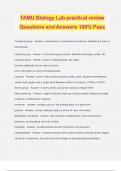
-
TAMU Biology Lab practical review Questions and Answers 100% Pass
- Exam (elaborations) • 13 pages • 2024
-
- £10.13
- + learn more
TAMU Biology Lab practical review Questions and Answers 100% Pass functional group - Answer- components of a biochemical molecule, identifies the type of biomolecule hydroxyl group - Answer- a functional group found in alcohols and sugars, polar, OH carbonyl group - Answer- found in carbohydrates, two types terminal aldehyde and an internal ketone one or the other on every monosaccharide carboxyl - Answer- found in fatty acids and amino acids, acidic, double bond between carbon and oxyg...

That summary you just bought made someone very happy. Also get paid weekly? Sell your revision notes on Stuvia! Discover all about earning on Stuvia


